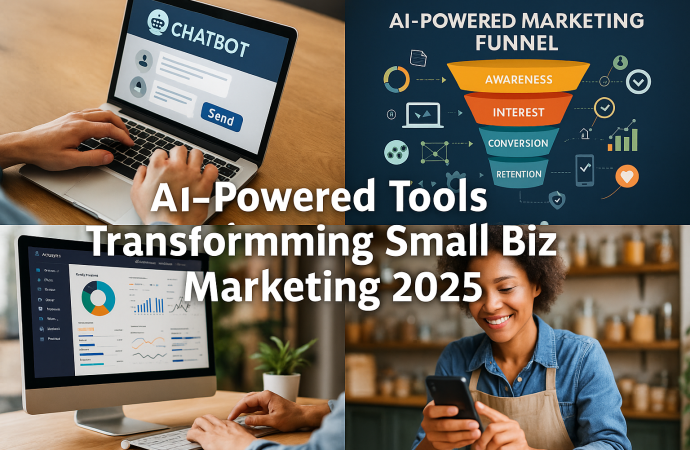Why 2025 Is a Tipping Point Five years ago, artificial intelligence felt like a luxury reserved for global brands with data teams. In 2025 that wall has fallen. Low-cost generative models, drag-and-drop dashboards, and subscription pricing mean even a two-person bakery can run campaigns that once demanded an agency retainer. New tools draft copy, design
Why 2025 Is a Tipping Point
Five years ago, artificial intelligence felt like a luxury reserved for global brands with data teams. In 2025 that wall has fallen. Low-cost generative models, drag-and-drop dashboards, and subscription pricing mean even a two-person bakery can run campaigns that once demanded an agency retainer. New tools draft copy, design videos, predict demand swings, and schedule social posts while owners sleep. The result is a crowded, sometimes confusing ecosystem. This guide sorts hype from help and spotlights the AI platforms delivering real wins for small and micro-businesses right now.
How We Chose the Stand-Out Tools
We scanned martech news feeds, analyst reports, and small-business forums, then filtered products through three questions:
- Does it solve a day-to-day pain? Scheduling, content gaps, data overload.
- Is the learning curve short? Time-starved founders need plug-and-play.
- Is pricing transparent and SMB-friendly? Freemium or low monthly tiers under US $100.
Only tools meeting at least two criteria made the list.
Table 1 – Key AI Marketing Platforms for Small Business 2025
| Platform | Core Use | Quick Win Example | Entry Cost / mo | |
|---|---|---|---|---|
| Bluumly | All-in-one AI marketing hub | Generates weekly email + social bundle in minutes | Free beta | |
| HubSpot Breeze | CRM + AI agents | Auto-segment contacts and draft nurture emails | Starter $20 | |
| ContentShake AI | SEO blog drafting | One-click article outlines with Semrush data | $29 | |
| Sprout Social AI Suite | Social listening & replies | Autowrites brand-voice replies at scale | $39 | |
| MarketTrends AI | Competitive intel | Monthly trend report on rivals & costs | $49 |
What Do These Tools Actually Do?

Image by: Yandex.com
Bluumly: Marketing Swiss-Army Knife
Bluumly launched its public beta in June with a mission to “hand micro-businesses their own agency.” The platform asks three onboarding questions—industry, target audience, monthly budget—then spins up a calendar containing email drafts, Instagram reels, and blog headlines. Owners can approve, tweak, or reject each suggestion. Early adopters report writing time dropping from four hours per week to under forty minutes.
HubSpot Breeze: AI Inside Your CRM
HubSpot’s new Breeze layer adds conversational “copilots” that sit on top of its free CRM. Ask, “Draft a three-touch upsell sequence for customers who bought within 90 days,” and the agent writes subject lines, body copy, and smart-field personalization. Breeze also includes “agents” that monitor pipeline stages and auto-nudge leads if emails go unopened for a set window.
ContentShake AI: SEO Without Headaches
Built by Semrush, ContentShake combines keyword data and a large-language model. Enter a topic like “sourdough starter tips,” and the tool suggests competitive headings, outlines, and internal links. A readability slider adjusts sentence complexity—handy when you need posts that both Google and tenth-grade readers can enjoy.
Sprout Social’s AI Reply & Insights
Sprout Social expanded its AI stack in late 2024. Users can highlight a batch of inbound comments, press “Smart Reply,” and receive on-brand answers ready to send or schedule. The same engine clusters follower sentiments, flagging potential crises before they trend.
MarketTrends AI: Mini McKinsey for $49
Traditional market research reports run thousands of dollars. MarketTrends AI scrapes public filings, job boards, and ad libraries, then feeds the data through proprietary indices to predict labor costs, raw-material price moves, and demand spikes—all delivered in a crisp monthly PDF. Perfect for a coffee-roaster deliberating when to lock bean contracts.
Practical Playbooks for Busy Owners

Image by: Yandex.com
Five-Step Email Launch Using Breeze
- Segment pull – Filter contacts who opened but never purchased.
- Prompt – “Write a 3-email series introducing our summer iced-coffee kit.”
- Tone tweak – Choose “friendly expert.”
- A/B line swap – Replace AI subject line on Email 1 with your own pun.
- Schedule – Spread over six days; Breeze auto-skips weekends if open rates drop.
One-Hour Blog Workflow With ContentShake
10 min – Pick keyword from Semrush suggestions.
15 min – Approve outline and pull in competitor gap questions.
25 min – Write intro and conclusion; let AI draft middle sections.
5 min – Run built-in plagiarism and readability check.
5 min – Export to CMS with metadata filled.
Real-Time Social Care Using Sprout
Open Smart Inbox at 9 a.m. Click “Generate Reply” on overnight messages. Approve and send in batches of five. Mark recurring questions and let the bot build a saved reply template. Result: one person clears 50 messages in 12 minutes.
Trend Forecast With MarketTrends AI
Upload last quarter’s sales CSV. The tool correlates SKU spikes with its macro-demand index. If rising raw-material costs coincide with strong demand, consider bulk purchasing. Set an alert threshold to email you if labor-cost index rises 5 points.
Common Roadblocks and Fixes
| Issue | Likely Cause | Simple Solution |
|---|---|---|
| Robotic copy | Over-reliance on default prompts | Add brand-voice samples and editing pass |
| Data privacy worry | CRM data feeding external models | Choose tools with on-premise or SOC 2 compliance |
| Workflow sprawl | Too many apps | Centralize through Zapier or native integrations |
| Budget creep | Multiple freemiums upgraded silently | Audit subscriptions quarterly |
Measuring ROI—Beyond Clicks
Small businesses often judge campaigns by opens or likes. AI tools surface deeper metrics:
- Customer-lifetime value lift – Breeze shows average purchase frequency before and after nurture sequences.
- Time saved – Sprout dashboards report minutes saved via Smart Reply. Multiply by staff hourly wage for hard dollars.
- Trend action accuracy – MarketTrends platform back-tests forecast accuracy; aim for 70 percent+ before using suggestions for large inventory bets.
Log these KPIs in a simple spreadsheet each month. Over time you’ll know which AI stack earns its keep.
The Ethical Side: Using AI Responsibly

Image by: Yandex.com
AI can amplify biases or misuse customer data. Follow these guardrails:
- Transparency – Disclose in footers when newsletters contain AI-generated sections.
- Review loops – Human-approve all responses that mention pricing or health claims.
- Opt-outs – Let subscribers request removal from AI-personalized lists.
Responsible use builds trust and future-proofs against tightening regulations.
What’s Next: 2026 Sneak Peeks
Analysts predict three evolutions:
- Voice-first prompts – Speak a campaign brief; tool outputs cross-channel plan.
- Multimodal ads – Single prompt yields video, banner, and copy variants auto-tested in real time.
- Hyper-local AI – Geo-fenced content swapping product images to match neighborhood demographics.
Stay flexible. Choose vendors that update models frequently or allow easy migration via open APIs.
Conclusion
2025’s AI marketing tools hand small businesses superpowers once reserved for Fortune 500 giants. Bluumly bundles a full agency in one tab, HubSpot Breeze personalizes campaigns from your CRM, ContentShake AI makes SEO blogging painless, Sprout Social automates brand-safe replies, and MarketTrends AI brings boardroom-level intel to corner-store budgets. Adopt them with clear goals, human oversight, and a watchful eye on ROI. Your reward is more time for product quality, customer relationships, and big-picture growth.
Call to Action: Ready to try these platforms risk-free? Download our free comparison worksheet featuring trial links, feature checklists, and ROI-tracking templates, and start upgrading your marketing week today.






















